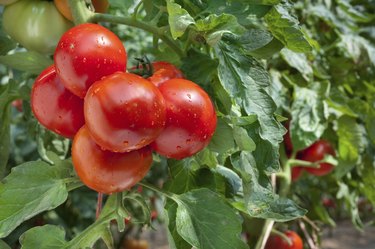
One of the most popular fruits in the garden, tomato (Lycopersicon esculentum), winter hardy in U.S. Department of Agriculture plant hardiness zones 10 and 11 but grown as an annual, is susceptible to many diseases. Cotyledons, the first, smooth-edged leaves, naturally fall away as true leaves grow, but if the true leaves start dying from the ground up, your tomato plant is likely afflicted by a fungus.
Early and Late Blights
Video of the Day
Early blight, caused by the fungus Alternaria solani, and late blight, caused by Phytophthora infestans, are named for the time of the season each typically appears. Both begin as lesions on lower leaves. Early season heat and humidity encourages the development of early blight which begins as dry, brown lesions surrounded by yellow. A mid-season cool, rainy spell with temperatures that do not climb above 79 degrees Fahrenheit during the day spurs the growth of late blight. It appears as watery, oozing dark lesions and leaves develop white mold around their edges. Both blights spread quickly and can defoliate plants.
Video of the Day
Septoria Leaf Spot and Leaf Mold
Septoria leaf spot (Septoria lycospersici) begins with dark spots with beige centers on lower, older leaves. Infected leaves turn yellow and fall -- and serve as host to little black spore colonies. The fungus is most active in cool, wet weather when daytime temperatures range between 68 and 77 degrees Fahrenheit. Septoria depends on plant-to-plant contact and does not persist in soil.
Leaf mold (Passalora fulva), on the other hand, thrives in hot, humid conditions where air circulation is poor. It appears as yellow spots that become moldy with gray spores, killing the leaf.
Fusarium and Verticillium Wilts
Those letters on plant tags stand for resistance to common tomato diseases. Two of these diseases, caused by Fusarium oxysporum and Verticillium albo-atrum fungi, cause wilting in lower leaves beginning with darkened veins rather than spots. They have no chemical controls, so keeping the tomato patch clean and free of weeds that might carry the fungi is especially important. Buy only hybrids or seed with "F" and "V" following their variety names, which denote resistance to the strains of Fusarium and Verticillium that commonly afflict tomatoes.
Prevention and Treatment
Fungal diseases persist in soil, plant matter or seed, making rotation of tomato plants, pulling spring "volunteers" and purchasing blight-free seeds a must. Affected branches and plants should be removed immediately and destroyed, never added to a compost pile.
Although little can be done to change the weather, plant tomatoes where they get morning sun and space them so air circulates to help foliage stay dry. Drip irrigate rather than water from overhead to minimize splashing spores and irrigation-generated humidity.
Use prepared fungicide sprays containing chlorothalonil, copper or mancozeb weekly in the calm of the morning to prevent or control blights and leaf spot and mold -- remember to wear gloves and wash your face and hands after using fungicides.
- Missouri Botanical Garden: Lycopersicon Esculentum
- Purdue University Extension: Five Steps for Healthy Garden Tomatoes
- Clemson Cooperative Extension: Tomato Diseases and Disorders
- Cornell University Vegetable MD Online: Verticillium Wilt of Tomato
- University of Maryland Extension: IPM Series: Tomatoes
- Washington State University: Physiological Leaf Roll of Tomato